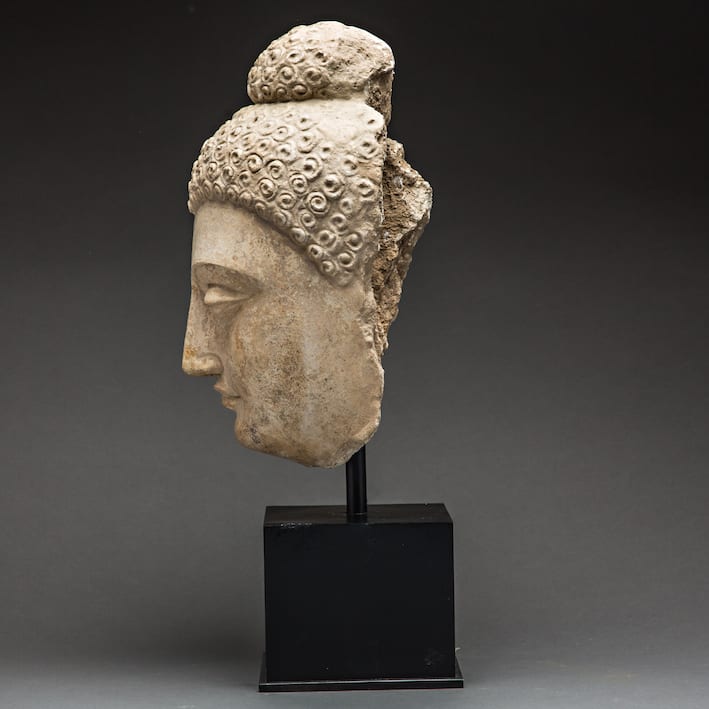Gandhara Stucco Head of a Buddha, 300 CE - 500 CE
Stucco
height 33.7 cm
height 13 1/4 in
height 13 1/4 in
LO.605
Further images
The ancient civilisation of Gandhara was located i the region encompassing modern northeaster Afghanistan and northwestern Pakistan. Situated at confluence of trading paths along the Silk Route, the area was...
The ancient civilisation of Gandhara was located i the region encompassing modern northeaster Afghanistan and northwestern Pakistan. Situated at confluence of trading paths along the Silk Route, the area was flooded in diverse cultural influence ranging from Greece to China. Gandhara flourished under the Kushan Dynasty and their great king,
Kanishka, who is traditionally given credit fo spreading the philosophies of Buddhism throughout central Asia and into China. This period is viewed a the most important era in the history of Buddhism.
After the conquests of Alexander the Great, the creation of Greco-Bactrian kingdoms, and the genera Hellenisation of the subcontinent, Western aesthetic became prominent. Greek influence began permeating into Gandhara. Soon sculptors based the images of the Buddha on Greco-Roman models, depicting Him as stocky and youthful Apollo, complete with stretched earlobes and loose monastic robes similar to a Roma toga. The extraordinary artistic creations of Gandhar reveal link between the different worlds of the East and West.
The historical figure, Buddha Gautama Sakyamuni is the Buddha of compassion who, having achieved the highest evolutionary perfection, turns suffering int happiness for all living beings. Born around 560 B.C.
somewhere between the hills of south Nepal and the Rapti River, his father was a Raja who ruled over the northeastern province of India, the district including the holy Ganges River. The young prince was married to Yashoda when he was about 17 years old and together they had a son named Rahula. At the age of 29, he left his life of luxury, as he felt compelled to purify hi body and make it an instrument of the mind by ridding himself of earthly impulses and temptations. The sculptural fragment depicts the bust of the Buddha. A inner calm and complacency is visible in his sweet smile. The sharply defined eyebrows arch gently downwards into his long, narrow nose. Such feature are characteristic of the Gandhara style. His hair i composed of rows of miniature spirals rendered in lo relief. His head is crowned by a prominent ushnisa,
or topknot, that is a symbol of his divine wisdom. The ushnisa is covered with the same spiral motif the conveys the texture of his curly hair. The artists o Gandhara were the first to represent the Buddha in hi human form, as opposed to a symbol such as hi footprint. This gorgeous head is a reminder of an ancient civilisation that, although vanished, helped spread the teachings of enlightenment throughout the heart of Asia.
Kanishka, who is traditionally given credit fo spreading the philosophies of Buddhism throughout central Asia and into China. This period is viewed a the most important era in the history of Buddhism.
After the conquests of Alexander the Great, the creation of Greco-Bactrian kingdoms, and the genera Hellenisation of the subcontinent, Western aesthetic became prominent. Greek influence began permeating into Gandhara. Soon sculptors based the images of the Buddha on Greco-Roman models, depicting Him as stocky and youthful Apollo, complete with stretched earlobes and loose monastic robes similar to a Roma toga. The extraordinary artistic creations of Gandhar reveal link between the different worlds of the East and West.
The historical figure, Buddha Gautama Sakyamuni is the Buddha of compassion who, having achieved the highest evolutionary perfection, turns suffering int happiness for all living beings. Born around 560 B.C.
somewhere between the hills of south Nepal and the Rapti River, his father was a Raja who ruled over the northeastern province of India, the district including the holy Ganges River. The young prince was married to Yashoda when he was about 17 years old and together they had a son named Rahula. At the age of 29, he left his life of luxury, as he felt compelled to purify hi body and make it an instrument of the mind by ridding himself of earthly impulses and temptations. The sculptural fragment depicts the bust of the Buddha. A inner calm and complacency is visible in his sweet smile. The sharply defined eyebrows arch gently downwards into his long, narrow nose. Such feature are characteristic of the Gandhara style. His hair i composed of rows of miniature spirals rendered in lo relief. His head is crowned by a prominent ushnisa,
or topknot, that is a symbol of his divine wisdom. The ushnisa is covered with the same spiral motif the conveys the texture of his curly hair. The artists o Gandhara were the first to represent the Buddha in hi human form, as opposed to a symbol such as hi footprint. This gorgeous head is a reminder of an ancient civilisation that, although vanished, helped spread the teachings of enlightenment throughout the heart of Asia.





